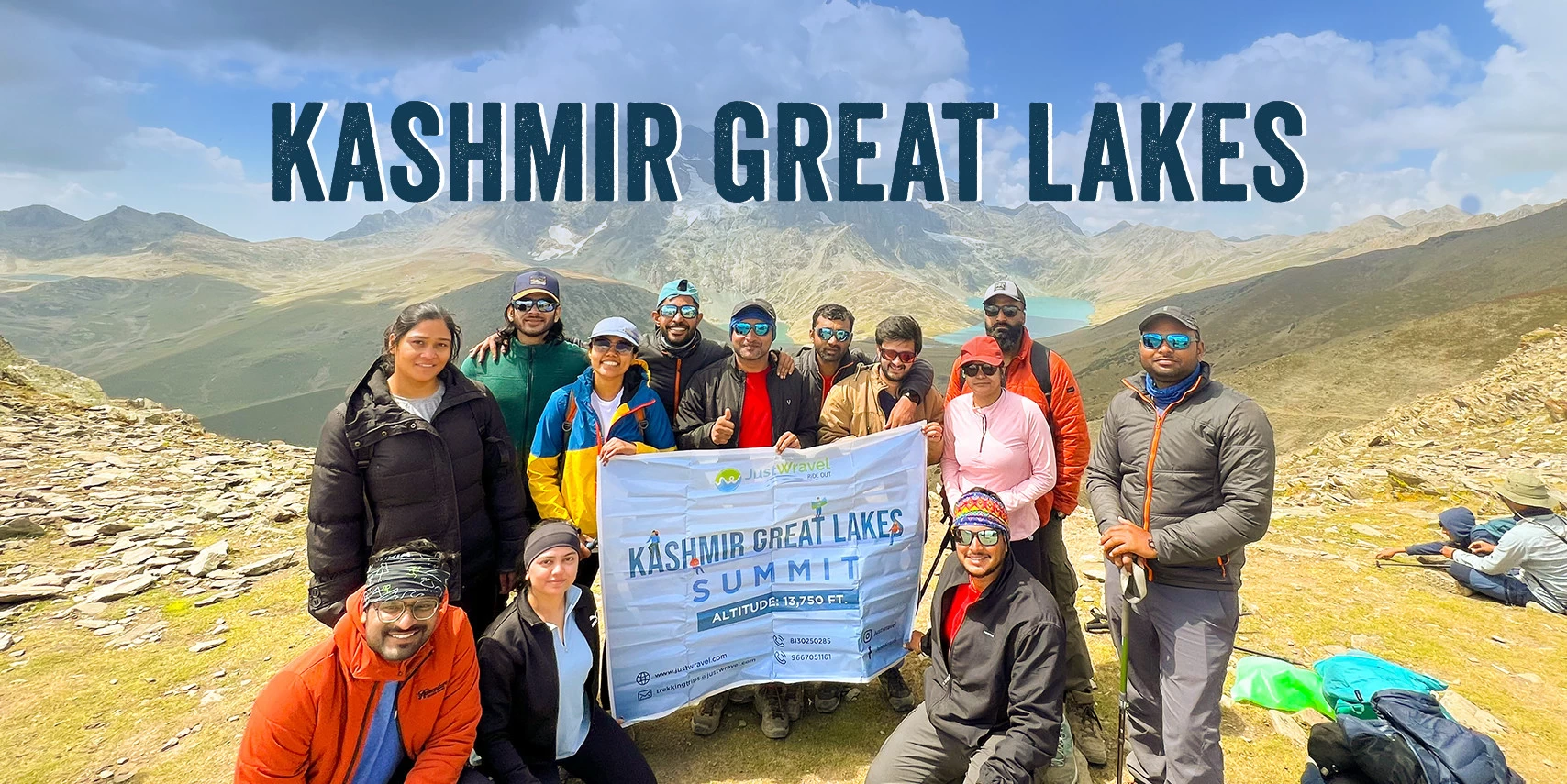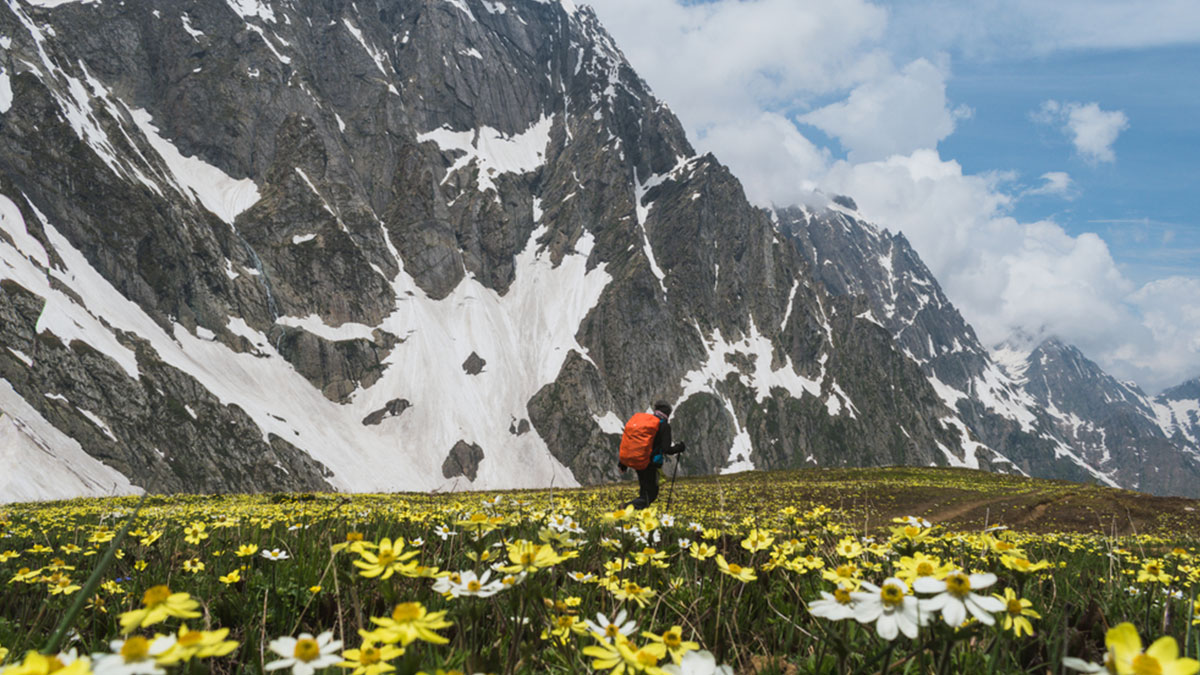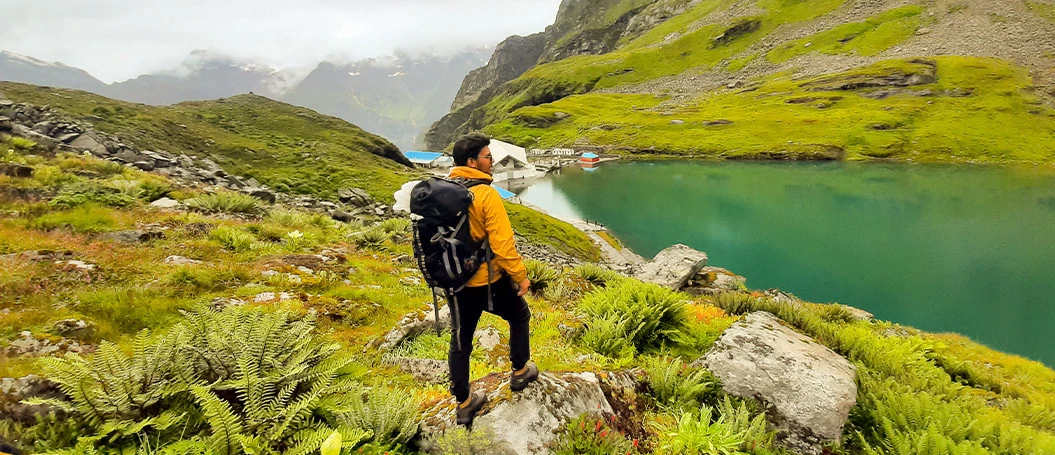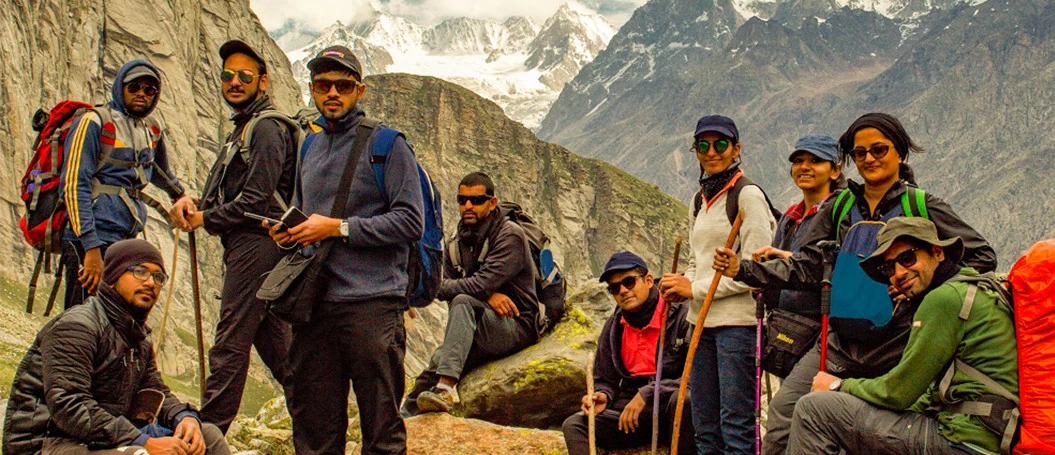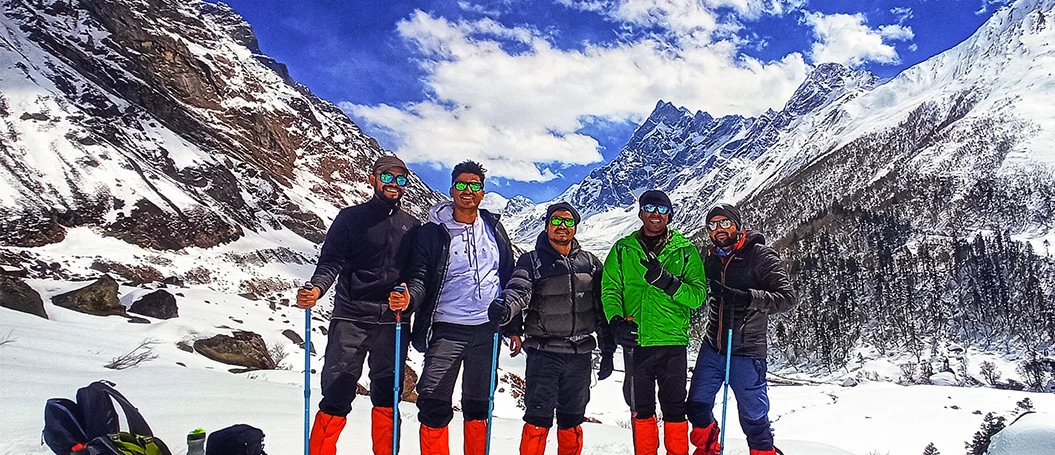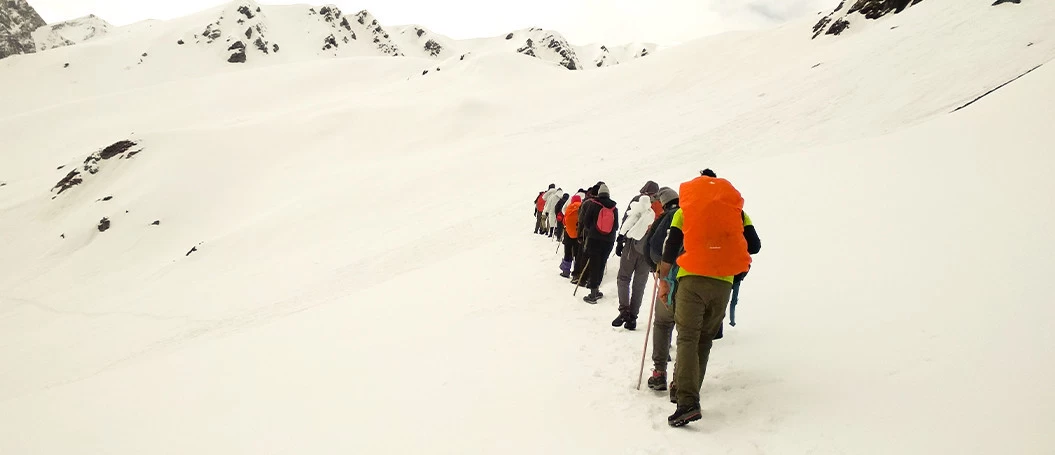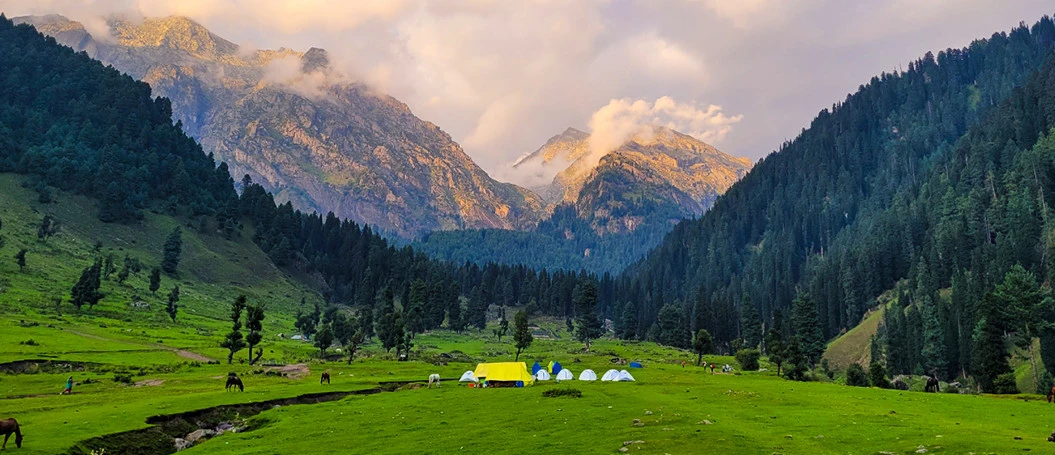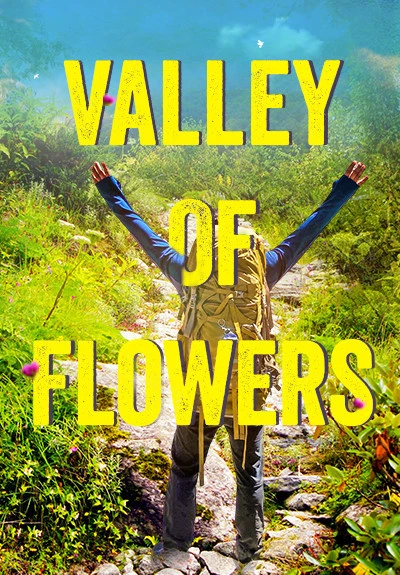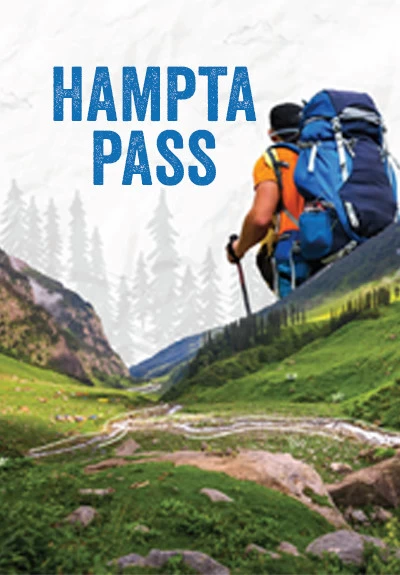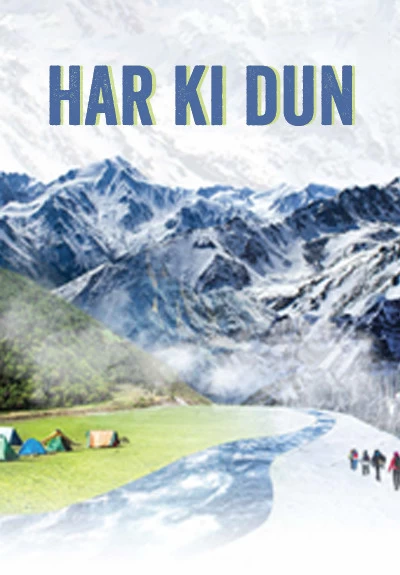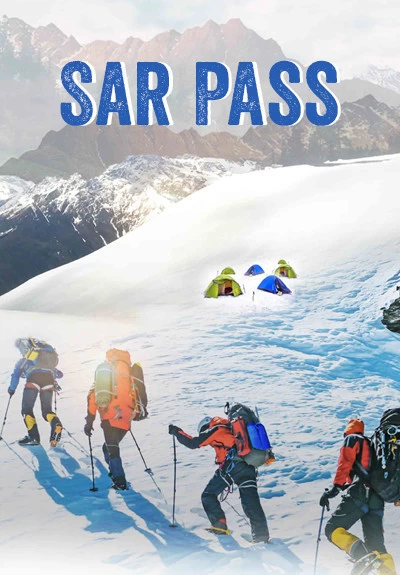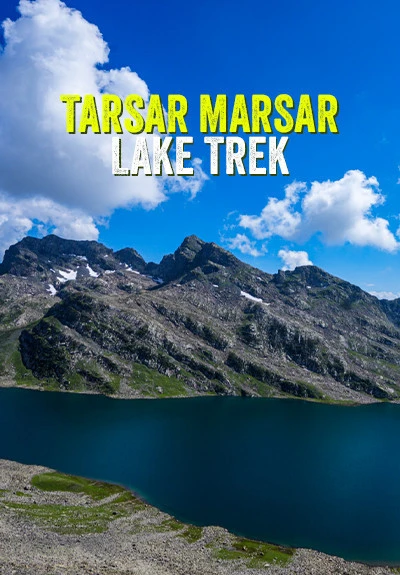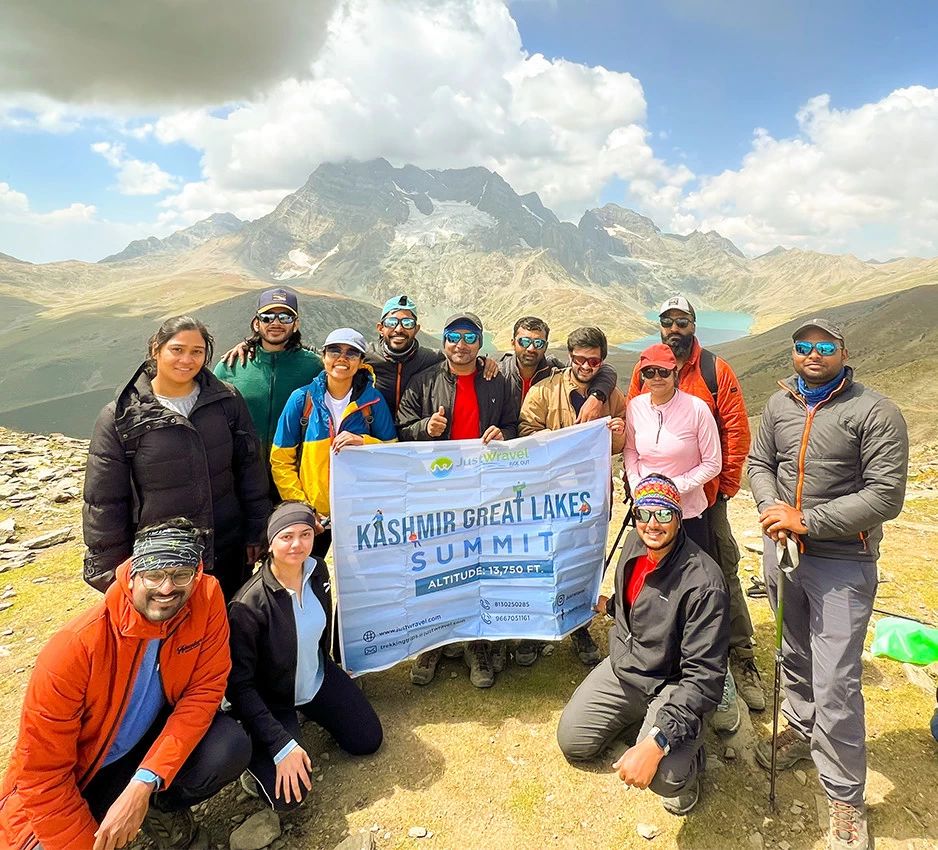

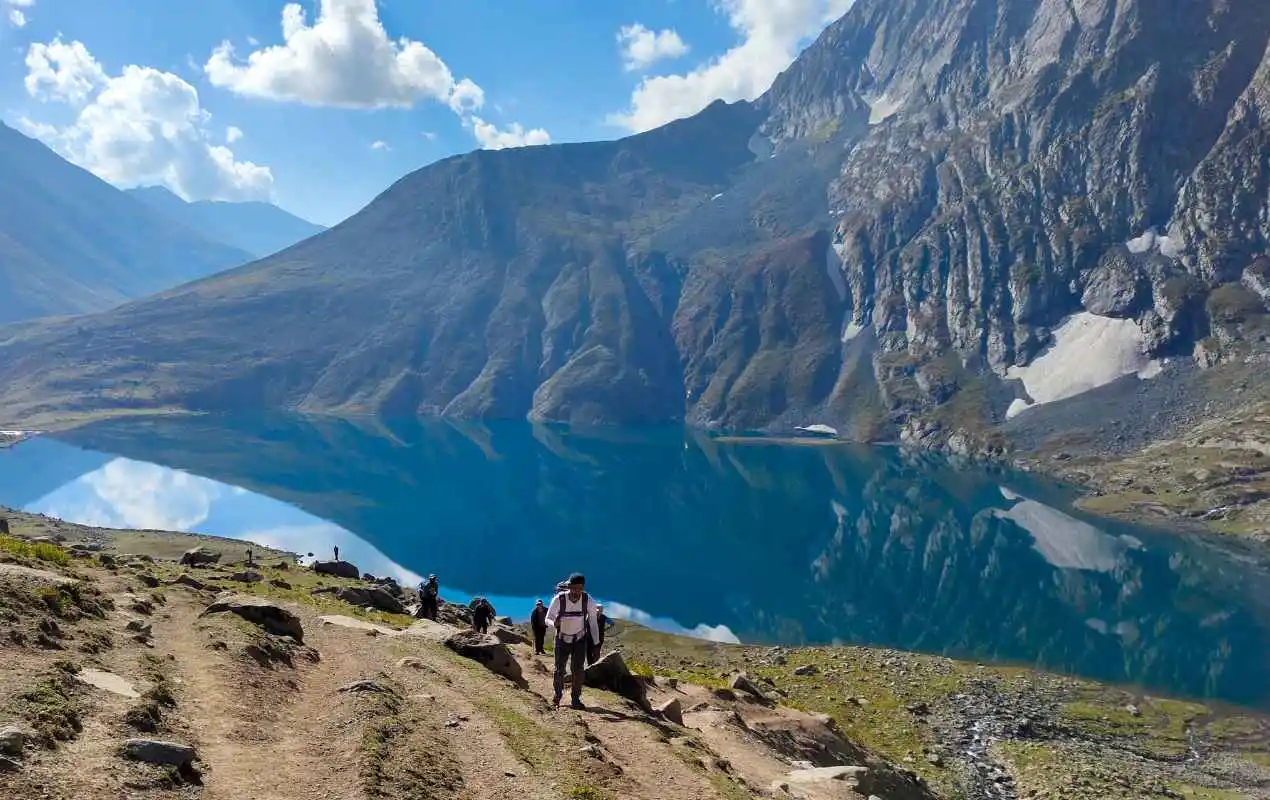

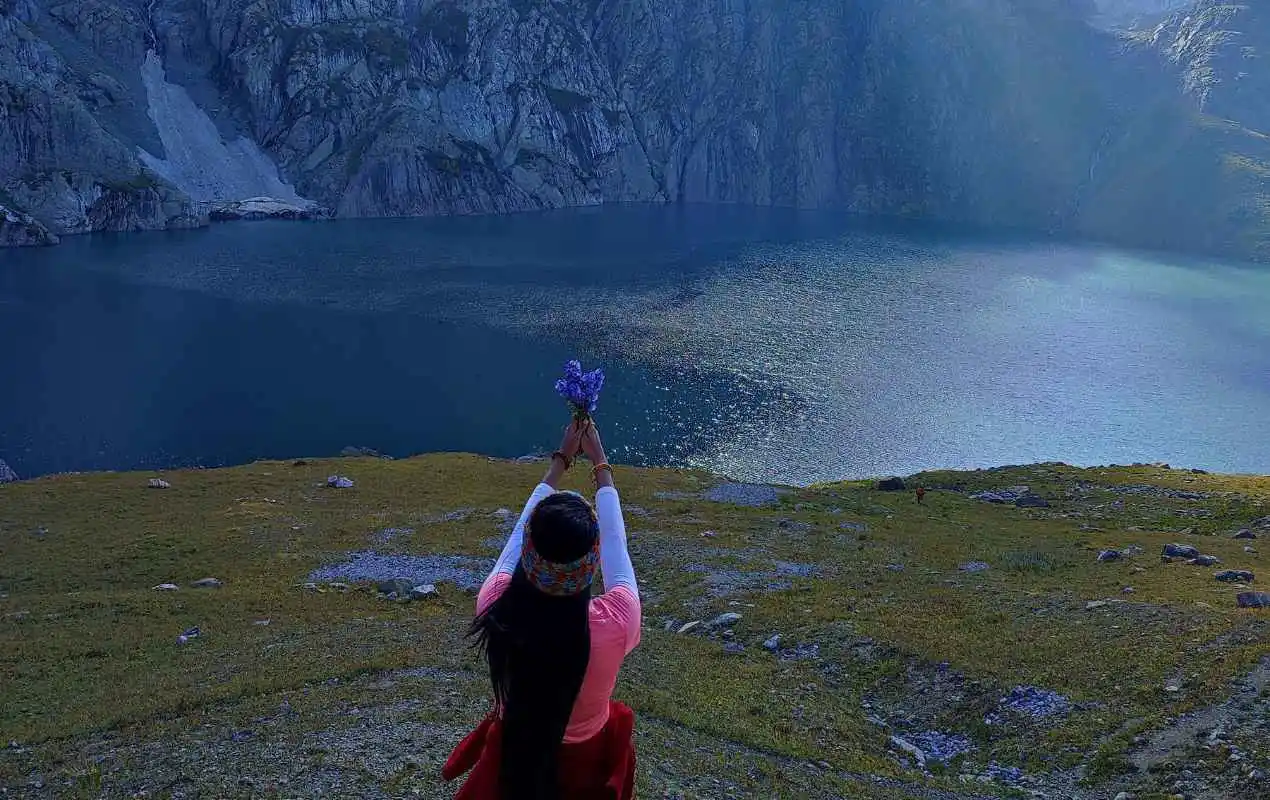
Kashmir Great Lakes Trek
Details
Inclusions
Safe Travel
Flexible Cancellation
Easy EMI
Certified Captains
24/7 Support
Overview
Kashmir is often called paradise on earth for its incomparable beauty and it is for that very reason that the Kashmir great lakes trek is one of its kind. As the name suggests, embarking on this trek means that you get to witness the magic of heavenly lakes embracing the Himalayas. Every waking moment brings you a view so beautiful and mystifying that it fills you with a sense of gratitude to be just alive and be able to witness it. From lofty mountains, green meadows unfurling their spring-colored blooms, and lakes resembling melted turquoise gems, words simply fail when it comes to describing the beauty that this trek to the lakes of Kashmir entails. However, the ever-changing landscape and the fact that beauty comes at a price, Kashmir too, unravels its hidden gems to those who are patient and determined. The Kashmir great lakes treks fall in the moderate to difficult trek and hence novice trekkers are often advised to gain the skills and experience the trek demands. For experienced trekkers, the Kashmir great lakes trek is still comparatively easier but no less challenging. But all the hardships are worth every second because you would be witnessing nature embodying slices of heaven in each and every corner. The meadows are adorned by pine and maple trees, trails consisting of serene alpine lakes, and valleys with sheep grazing and wind blowing. Every step takes you further into the fairytale land that is Kashmir. Each day on these 8 days of Kashmir great lakes treks, you would be stepping into a new valley because the trail is a getaway to one valley after another, each one more breathtaking than the previous one. Bridging the gaps between these valleys and meadows and connecting them through a core link is many passes. In this Kashmir Great Lakes itinerary, we start our journey from Srinagar and drive to Sonamarg, located at an altitude of 7,800ft to reach Shitkadi Village which is the actual base camp for the Kashmir great lakes trek. The drive takes up to 3 hours of time but the beautiful scenery makes it seem extremely short as you get to witness the beauty of Kashmir throughout your drive. The next day we head out for Nichnai. 3-hour ascent followed by a 1-hour descent and finally a gentle ascent to Nichnai. The trek commences 3 km out of Sonamarg on the Srinagar road and stretches for a duration of five hours with the first three hours of the trail being a steep ascent. Afterward, the rest of the one hour is spent descending before finally continuing with a gentle ascent till we reach Nichnai which is located at an altitude of 11, 811 ft.
The trail starts with a road track with the Sindh river flowing through it. The trekking trail starts along the same track but soon attains elevation. After a few minutes of walking, you’d reach a lush green meadow and from here on, there is no looking back as the Sonamarg town stays below with the maple and pine trees at the top of the meadows overlooking it. The trail descends at the tree line before climbing up again. A coniferous forest of maple trees comes into view and as you walk on the fallen leaves and fresh grass, you start to realize just how beautiful even the most mundane things in Kashmir seem to be. For the next hour, the trail takes you uphill with a few openings in the green canopies leading your way. You’d get to glimpse at the stunning landscape of the Sonamarg valley from here as you stand on an elevated ridge in the meadow. The slope turns down and silver birch trees come into view. Stretching to a vast expanse of almost 40 ft, the grassland seems like the garden of Eden with few nooks overflowing with water. The peaks covered with snow that beckon you closer encompass Shekdur, a beautiful spot with Bhoj trees surrounding it. Our campsite Nichnai is at least 2 more hours away from here and the meadow stretches for at least half an hour before you get to the end of the silver birch trees and descend gently into the river valley. The valley signifies the start of Nichnai with the river stream flowing alongside, overlooked by mountains on either side. The terrain is rocky for at least an hour before you get to see green patches of grass with the valley widening between mountain ranges. A glimpse at the triangular peaks is your sign that you’ve reached your destination and should camp on the flat grounds of Nichnai.
The next day consists of a small descent with a flat walk into the meadow to reach Vishansar Lake located at an altitude of 12,000ft. The trekking duration would be at least 6 hours with the first milestone being the Nichnai pass. As you keep traversing the trail for more than an hour, you will gradually start ascending again and after that, it’s an uphill climb until you reach the pass. A small lake at the base of the mountains will come into view followed by a ridge, and an inward twist of the trail that you have to cross twice before you reach the pass which seems like a wide tunnel of sorts with snow-covered peaks on one hand and vertical rock walls on the other. At an altitude of 13,500ft, the gradual ascent followed by a rapid descent makes it easier for you to navigate through the trail without facing any difficulties. Soon, the rocky trail gets replaced by blooming flowers giving way to lush green meadows with mountains overlooking them. With a river flowing from the pass to the meadow ahead of you, you’d also see a sparkling waterfall cascading down from the cliffs above and forming a commune with the river. Soon, you’ll find yourself traversing on flat meadows, with the Himalayan ranges standing proud on one side and barren mountains mimicking the mountains of Ladakh on the other. The striking contrast between these two mountain ranges will surely take your breath away. Another half an hour will lead you to yet another stream which you will have to cross and continue walking in the meadow before you reach the end of the valley. The perpendicular stream that you witness originates from Vishansar lake with the lake itself being half a kilometer away and nestled at an altitude of 100ft higher than where you will be setting your campsite. It’d hardly take 7-10 minutes for you to reach the lake which is at the base of four majestic mountains, reflecting the Kishansar peak on its surface. The most fascinating thing about this lake is that the color you see of the lake depends entirely on the time of the day you’d be looking at it. The reflections are wonderful when the lake is still. The lake gains a certain charm when the sunlight falls on the surface and is a must-visit when you are on a Kashmir great lakes trek. The next day we would stay at the campsite for acclimatization.
The next part of the trail is almost 10 kilometers long and falls in the moderate category when it comes to the difficulty level of the Kashmir great lakes trek. Consisting of a steep ascent and lined with ridges, it is important to maintain proper footing as we move towards Gadsar pass. The next lake that we would seeing in the Kashmir great lakes trek is the Kishansar lake which is located at an elevation of 500ft higher than Vishansar lake. It takes about 45minutes to reach Kishansar lake from the campsite and you have to cross the stream before climbing uphill on the right side of the Vishansar lake With a vast meadow stretching around it, Kishansar lake is equally beautiful as its predecessor if not more. The trail climbs up to the top of the ridge and on the top of the ridge is the Gadsar pass which is located at an altitude of 13,750 ft. After almost an hour of climb, you will get to see the picturesque view of seeing both lakes together here. On the other side of the Gadsar pass, you see a long valley with 2-3 small lakes along with a few peaks visible in a far distance. You might find snow at the Gadsar pass and even as you descend, you will find traces of snow. The first small lake on the left side that comes into view is Yamsar lake. Beyond Yamsar is another nameless lake. An hour's descent leads you into lush green meadows again with a narrow valley with mountain ranges on either side. Flowers line your trail from here, making the view all the more beautiful and charming
The beginning of blue irises signifies that you are closer to Gadsar lake, one of the most pristine lakes on this trek. The Yamsar, the nameless lake, and Gadsar are all connected by a stream as water flows from the higher lake to the lower. Gadsar lake is located at an altitude of 12,500ft and nearby is the ideal campsite in close proximity to the army base camps. If you are near the Gadsar army camp, it is crucial to report to them as soon as possible. It takes 2-3 hours for them to give you a green signal after all details of the trekkers and staff including original id cards are recorded, collected, and checked.
We head out for a 12 km long trek and start by moving away from the army camp and towards the stream. Crossing the stream which is at an altitude of 10,600ft will lead you up to the mountains. From here on, the Satsar campsite is 10 kilometers away and at an elevation of 12,000ft. You’d soon realize that you are overlooking the treeline with the river valley below you. Once you attain an altitude of 11,500ft, the trail becomes flat with mountains surrounding the lush green meadows. This region is called Maengandob and has a stunning landscape of streams running across the green bed. We would be setting up camp here, near the Satsar lake which is actually a collection of 7 lakes. Beyond the ridge lies the Satsar army check post, and it is the third line of defense from the LOC you are again required to go through the process of ID proof checking, collection, and questioning.
We will head out of the camp to reach the biggest Gangabal Lake. This part of the trek falls under the moderate category when it comes to the difficulty level of Kashmir Great Lakes Trek as the terrain is made up of boulders but ends up being extremely rewarding as you reach the biggest Satsar lake by the end of this trail. After half an hour of walking, the forest line would commence after which a range of ridges come into view, elevated at a height of 1000ft and we take the zig-zag paths to reach our next campsite located at an altitude of 11,800ft. The trail after crossing the ridges astonishes you with its bareness except for the pine trees that line the huts of the tribes here. The ridge top acts as a vantage point from where you get stunning views and get to see two lakes lying next to one another.
A stream runs water from the higher altitude lake to the lower one. Two more blue lakes are seen, one at a distance. The smaller lakes are nameless but the biggest amongst the set is the Gangabal lake accompanied by Nundkol and our campsite is below. The route descends a bit more and ascends again to the lake. The ascent is dry and rocky but on the descent, you cross a stream mid-way from where you can refill your water bottles. An hour and a half of steep descent bring you to lush meadows again and as you walk for a kilometer again, you see the tree line again. A swift climb consisting of descending and crossing a stream brings you to the shores of Nundkol lake which lies at the base of the Harmukh peak. The Harmukh glacier hangs from the cliff of the mountains. We set up camp here. This day in the Kashmir great lakes trek stretches to a distance of 12 kilometers and will strain your lower limb muscles. From the Gangabal campsite, we descend along the stream and head towards the tree line. After walking for an hour, the ridges that you were walking upon disappear, and traces of civilization start to appear. The Harmukh peak stands majestically, overlooking you and the meadow lined with yellow flowers. A series of ascend and descent takes place and you drop to 10,800ft at the tree line but climb again to 11,000ft. For about 6 km you maintain an altitude of 10,800ft, traversing through the pine forests before finally entering. After you’ve completed two-thirds of the trail, the actual descent starts which is steep so trekkers should maintain proper footing as the trail is trodden. In a span of 4 kilometers, you drop down to an altitude of 3000ft. Naranag starts to come into view at around 8500ft. The last stretch becomes an endurance test but soon the stone-paved track comes up and in no time you enter the main road of Naranag and from here you drive to Srinagar.
Gallery




.png)
Itinerary
1
Day
Srinagar Arrival | Drive to Sonamarg (90 Kms, 4 Hrs)
2
Day
Trek to Nichnai via Shekdur (11 Kms, 8 hrs)
3
Day
Nichnai to Vishansar lake via Nachnai Pass ( 12 Kms, 7 hrs)
4
Day
Vishansar lake to Gadsar via Gadsar Pass (14 Kms, 8 hrs )
5
Day
Gadsar to Satsar (12 Kms, 6 Hrs)
6
Day
Satsar to Gangabal twin lakes via Zaj Pass (11 Kms, 6 Hrs)
7
Day
Gangabal to Naranag (11 Kms, 6 Hrs) | Drive to Srinagar
Age Limit (Trip Wise)
Weekend
Getaways
18-38
Himalayan
Treks
18-48
Backpacking
Trips
18-40
Biking
Trips
18-45
Customized
Trips
No Limit
Inclusions & Exclusions
| Inclusions | Exclusions |
Accommodation: 6 Nights of Tented Accommodation on a double / triple-sharing basis as per booking. Meals: All veg meals from day 1st Dinner to day 7th Breakfast. Snacks: Morning / Evening Tea / Coffee with light snacks. Camping logistics: Tent, Sleeping bags, Mattresses, Dining tent, Toilet tent. Trek Leader: Qualified and Experienced Trek leader and support staff. Permits: All necessary fees and permits. Safety Equipment: Basic First Aid kit with Oximeter and Oxygen Cylinder. Guide ratio: 1:10 | Transportation from Srinagar TRC – Sitkari / Naranag – Srinagar TRC Any expenses of personal nature. Meals during transit. Insurance of any kind. Any fees and permits (for non-Indians). Unscheduled delay due to a landslide. Cost Escalation due to “Force Majeure and Evacuation charges”. Anything not mentioned explicitly in the above program. Note: The pick-up from Srinagar TRC will be at 11 AM. We will arrange the transportation from Srinagar TRC to Sitkari and Return from Naranag to Srinagar TRC at an additional cost of approx. Rs. 4500 per vehicle one way. The amount would be paid directly to the driver and participants are expected to share the cost of the vehicle (One cab can accommodate 5-6 trekkers). Documents required for the Permits : Aadhar Card , Medical Certificate and Travel Insurance |
Cancellation Policy
| Upto 21 days | 20-15 days | 14-8 days | 7-0 days | |
| Batch Shifting | ||||
| Cancellation Charge | Free Cancellation | 25% of the Trip Amount | 50% of the Trip Amount | 100% of the Trip Amount |
| Booking Amount | Refunded in mode of Credit Note | Adjusted in Refund Deduction | Adjusted in Refund Deduction | No Refund |
| Remaining Amount | Full Refund (minus) booking amount | Refund (minus) 25% of the trip amount | Refund (minus) 50% of the trip amount | No Refund |
Payment Policy
| Upto 21 days | 21-15 days | 14-08 days | 07-03 days | |
|---|---|---|---|---|
| Booking Amount | ||||
| 50% Payment | Optional | Compulsory | ||
| 75% Payment | Optional | Optional | Compulsory | |
| 100% Payment | Optional | Optional | Optional | Compulsory |
Things To Pack
Rucksack:
You must pick a good quality backpack with a comfortable fit and straps that won’t give you shoulder pain. You can check out your nearest Decathlon store for a good trekking backpack.
You must pick a good quality backpack with a comfortable fit and straps that won’t give you shoulder pain. You can check out your nearest Decathlon store for a good trekking backpack.
Day Bag / Day Pack:
When you head towards the summit, you are required to carry only a few necessary items and for that, you need a day backpack as you will leave your bigger one on the campsite.
When you head towards the summit, you are required to carry only a few necessary items and for that, you need a day backpack as you will leave your bigger one on the campsite.
Hiking Shoes :
Durable footwear designed for rugged terrains.
Durable footwear designed for rugged terrains.
Floaters or Sandals:
Although the entire trek requires a good quality shoe, you still need to let your feet breathe to avoid chafing and blisters. When you are at the camp, a good pair of sandals and floaters will help you to move freely.
Although the entire trek requires a good quality shoe, you still need to let your feet breathe to avoid chafing and blisters. When you are at the camp, a good pair of sandals and floaters will help you to move freely.
Tees / Tshirts:
You must keep at least three pairs of quick dry tees so that you can wash them in between stops for proper hygiene.
You must keep at least three pairs of quick dry tees so that you can wash them in between stops for proper hygiene.
Poncho:
A poncho is an evolved form of a raincoat that provides coverage to your body as well as your bag and ensures total water protection from rain.
A poncho is an evolved form of a raincoat that provides coverage to your body as well as your bag and ensures total water protection from rain.
Quick Dry Towel:
A quick dry towel will help in maintaining proper hygiene. It must dry quickly because the wet fabric will only increase the chance of bacterial growth.
A quick dry towel will help in maintaining proper hygiene. It must dry quickly because the wet fabric will only increase the chance of bacterial growth.
Sanitizer:
Essential for maintaining cleanliness while trekking.
Essential for maintaining cleanliness while trekking.
Sun Cap / Hat:
A lightweight sun cap with side flaps is perfect to keep your head cool and avoid sunburns on a sunny day.
A lightweight sun cap with side flaps is perfect to keep your head cool and avoid sunburns on a sunny day.
Sunscreen SPF 40+:
To avoid sunburns and chafing, you need to put on sunscreen as well as cold cream.
To avoid sunburns and chafing, you need to put on sunscreen as well as cold cream.
Water Bottle (Re-usable):
Hydration is extremely important when it comes to trekking. Carrying a water bottle that you can refill with Himalayan water is a must.
Hydration is extremely important when it comes to trekking. Carrying a water bottle that you can refill with Himalayan water is a must.
Personal Toiletries:
A bag with all your essentials including napkins, toothpaste, sanitizers, paper soap, etc should be carried in a ziplock bag.
A bag with all your essentials including napkins, toothpaste, sanitizers, paper soap, etc should be carried in a ziplock bag.
Personal Medication / First Aid:
A few cuts and bruises are almost inevitable when you are on a trek so carrying a medical kit with bandages, Dettol, etc is necessary.
A few cuts and bruises are almost inevitable when you are on a trek so carrying a medical kit with bandages, Dettol, etc is necessary.
Sun Glasses / Reading Glasses:
Photochromatic glasses are specs that are designed to transform into anti-glare shades depending upon exposure to the sun. They are good when it comes to eye protection but one can also opt for clip-on glasses etc.
Photochromatic glasses are specs that are designed to transform into anti-glare shades depending upon exposure to the sun. They are good when it comes to eye protection but one can also opt for clip-on glasses etc.
Charger:
To keep your electronic devices powered during the trip.
To keep your electronic devices powered during the trip.
Power Bank:
Ensures your devices stay charged when there are no outlets.
Ensures your devices stay charged when there are no outlets.
Personal Documents & ID's:
Identification proofs like Aadhar Card, Drivers License.
Identification proofs like Aadhar Card, Drivers License.
Laundry Bag (Waterproof):
In case your clothes get wet or your garments don’t dry, you can carry them in polythene. However, make sure that all the plastic that you are carrying into the woods leaves with you. Don’t litter in the mountains.
In case your clothes get wet or your garments don’t dry, you can carry them in polythene. However, make sure that all the plastic that you are carrying into the woods leaves with you. Don’t litter in the mountains.
Track Pants:
A good pair of track pants made of polyester will let your skin breathe. They’re lightweight, dry easily, and comfortable to walk around in. You can easily avoid chafing and rashes by investing in a good pair of track pants.
A good pair of track pants made of polyester will let your skin breathe. They’re lightweight, dry easily, and comfortable to walk around in. You can easily avoid chafing and rashes by investing in a good pair of track pants.
Trekking Shoes:
A good trekking shoe is comfortable, provides ankle support, and has a good grip as well. They shouldn’t be chunky, instead, they should be lightweight and sturdy.
A good trekking shoe is comfortable, provides ankle support, and has a good grip as well. They shouldn’t be chunky, instead, they should be lightweight and sturdy.
Cotton Socks:
Cotton socks are extremely comfortable to move around in and are lightweight as well which is why you can always count on a good pair of cotton socks while trekking. However, keep in mind to change them and avoid wearing them when they are wet.
Cotton socks are extremely comfortable to move around in and are lightweight as well which is why you can always count on a good pair of cotton socks while trekking. However, keep in mind to change them and avoid wearing them when they are wet.
Woolen Socks:
A good pair of woolen socks, especially merino, are comfortable, limit odors and provide adequate insulation from the cold so you can wear them at night.
A good pair of woolen socks, especially merino, are comfortable, limit odors and provide adequate insulation from the cold so you can wear them at night.
Woolen Gloves:
Insulated gloves help in maintaining proper body heat in your hands and also provide a better grasp on trekking poles.
Insulated gloves help in maintaining proper body heat in your hands and also provide a better grasp on trekking poles.
Main Jacket:
It’s emphasized that you need to carry proper layers so you can avoid getting cold which is why you need to carry a heavy jacket that you can put on over your other clothes.
It’s emphasized that you need to carry proper layers so you can avoid getting cold which is why you need to carry a heavy jacket that you can put on over your other clothes.
Woolen Cap:
A woolen cap will help prevent cold when you ascend to high altitude. You can also cover your ears to avoid any pain and discomfort you might face in them when going at high altitudes.
A woolen cap will help prevent cold when you ascend to high altitude. You can also cover your ears to avoid any pain and discomfort you might face in them when going at high altitudes.
Hoodie:
A versatile layering option for various temperatures.
A versatile layering option for various temperatures.
Scarf / Balaclava:
Along with sun rays and chilly winds, you also get hit by dirt and grime during treks which is why it's important to carry a scarf or balaclava so you can cover your face when needed.
Along with sun rays and chilly winds, you also get hit by dirt and grime during treks which is why it's important to carry a scarf or balaclava so you can cover your face when needed.
Head Lamp:
You can’t rely on moonlight when you are in the mountains. A torch or even a headlamp with a fresh pair of batteries is always a good idea to bring along.
You can’t rely on moonlight when you are in the mountains. A torch or even a headlamp with a fresh pair of batteries is always a good idea to bring along.
Trekking Pole:
The trekking pole assists in more than one way. It saves energy while also providing stability and helps you to maintain proper balance.
The trekking pole assists in more than one way. It saves energy while also providing stability and helps you to maintain proper balance.
Camera:
This should be obvious. To make sure that you get to capture all the great moments from your trek. Make sure that you have enough storage and some extra batteries as well.
This should be obvious. To make sure that you get to capture all the great moments from your trek. Make sure that you have enough storage and some extra batteries as well.
Riding Gear:
If your trip involves biking or motorcycling.
If your trip involves biking or motorcycling.
Moisturiser & Cold Cream:
To avoid sunburns and chafing, you need to put on sunscreen as well as cold cream.
To avoid sunburns and chafing, you need to put on sunscreen as well as cold cream.
Lip Balm:
Your lips can become chapped due to the harsh cold winds so it's important to keep them moisturized.
Your lips can become chapped due to the harsh cold winds so it's important to keep them moisturized.
Sanitary Pads:
Essential for feminine hygiene.
Essential for feminine hygiene.
Insect Repellent:
Guards against pesky bugs and insects.
Guards against pesky bugs and insects.
Cash:
Emergency funds for unexpected situations.
Emergency funds for unexpected situations.
Thermals:
Thermal is a piece of garment that helps in keeping your body warm in cold temperatures. It is a necessary item that you need when going on a high-altitude trek.
Thermal is a piece of garment that helps in keeping your body warm in cold temperatures. It is a necessary item that you need when going on a high-altitude trek.
Snacks / Dryfruits / Energy Bar:
Provides quick energy on the go.
Provides quick energy on the go.
Positive Attitude:
The most important item for a successful trek or trip, keeping your spirits high and adaptable to the challenges of the journey.
The most important item for a successful trek or trip, keeping your spirits high and adaptable to the challenges of the journey.
Everything you need to know about Kashmir Great Lakes Trek
The Kashmir Great Lakes Trek is considered one of the most beautiful treks in India, offering a 360° view of panorama mountains, rolling meadows, alpine lakes, and valleys. The trek is set on a canvas that's larger than life, with every day presenting a 360° panorama of wild, rugged mountains, rolling meadows, and turquoise alpine lakes. The trek is situated 75 km northeast of Srinagar and covers more than six alpine lakes and five very different valleys, making it a moderate-difficult trek spanning over six days. The lakes on the trek, such as Vishansar and Kishansar, are connected, with the same water flowing in both. Interestingly, no algae formation can be found in these two lakes, which means that nothing can grow in this lake except for trout fish. Gadsar Lake, on the other hand, appears green due to algae growth. The Kashmir Great Lakes Trek is also known for its meadows, which come in every shape and size, sometimes many in a day. After this trek, every other trek feels as though it is a movie on a small screen due to its grandeur.
How to reach Kashmir Great Lakes Trek
By Flight: Traveling to Srinagar can be done via different modes of transportation. If you prefer flying, the closest airport is Sheikh ul-Alam International Airport, also known as Srinagar Airport, with the airport code SXR.
By Train: For those who prefer traveling by train, it's important to note that there are no operational rail-trails within the picturesque valley of Srinagar. The nearest railway station is Jammu Tawi Railway Station, which is approximately a 6-and-a-half-hour journey to reach Srinagar.
By Bus: If you choose to travel by road, Srinagar is easily accessible by cab, vehicle, or bus. While the roads are generally in good condition, there are mountainous areas and rough patches that may require you to travel at a slower pace.
Best Time to Visit Kashmir Great Lakes Trek
The period from June to September is considered the optimal time of year to embark on the Kashmir Great Lakes Trek. This is when the valley is at its most enchanting, adorned with vibrant blooming flowers and lush green landscapes that will truly captivate you.
The Kashmir Great Lakes Trek is specifically designed for adventure enthusiasts and nature lovers seeking a rejuvenating experience amidst breathtaking scenery. This monsoon trek offers a unique opportunity to immerse oneself in the abundant beauty of Kashmir in a truly unparalleled way. Prioritizing safety, it is recommended to consult the weather forecast before finalizing your trekking dates.
Highlights of Kashmir Great Lakes Trek
During the Kashmir Great Lakes Trek, trekkers have the opportunity to witness several stunning alpine lakes and mountain passes. Some of the lakes and passes you can experience during this trek include:
Lakes:
- Vishnusar Lake: Situated at an altitude of 12,700 feet, this lake is one of the first lakes trekkers encounter on the journey.
- Kishansar Lake: Connected to Vishnusar Lake, Kishansar Lake offers a serene setting with its turquoise water.
- Gadsar Lake: Known for its green appearance due to algae growth, Gadsar Lake is a picturesque stop along the trek.
- Gangabal Lake: Located near Nundkol Lake, Gangabal Lake offers iconic views and a perfect spot for a lunch break during the trek.
- Nundkol Lake: Another beautiful lake on the trek, Nundkol Lake is part of the twin lakes along with Gangabal Lake
Passes:
- Nichnai Pass: This pass is one of the first high-altitude passes on the trek, offering panoramic views of the surrounding landscapes.
Gadsar Pass: Known for its challenging terrain, Gadsar Pass provides trekkers with breathtaking views of the Great Kashmir Lakes Trek
VIDEOS
Memories for Life
posts
Instagram Images
REVIEWS
What our Clients Say About Us
blogs
Our Blogs
Faq
Have any Doubts
What is the highest altitude achieved on the Kashmir Great Lakes Trek?
The highest altitude achieved during the Kashmir Great Lakes Trek is 13,750 ft which is the Gadsar Pass, located on top of a ridge that appears after climbing uphill from the Kishansar Lake.
How do I prepare for the Kashmir Great Lakes Trek?
Kashmir Great Lakes trek is considered to be a moderate trek that gradually becomes difficult as you traverse the many steep ascends and descents throughout the trail. There are a few basic fitness tips that you can follow when preparing for the Kashmir Great Lakes Trek
1) Run for 30 - 45 mins at least twice a week.
2) Stair climbing. Skip the elevators and take the stairs instead.
3) Keep your body active by doing regular exercises. Jogging, Skipping and other cardiovascular activities help build endurance which would help you when you're trekking.
4) Train with your backpack before your trek.
Is Kashmir Great Lakes Trek worth it?
The Kashmir Great lakes trek is undoubtedly the most beautiful Himalayan trek with its pristine lakes, enchanting valleys, and lush green meadows. It is an experience that every trekker must tick off their bucket list. The fact that it offers such diverse trails and unfolds a different landscape with every step is just one of the reasons that make the Kashmir Great Lakes trek absolutely worth it.
Can Kashmir Great Lakes Trek be done solo?
Trekking solo in the Himalayas always comes with a lot of risks. It is not advisable for novice trekkers to do any trek solo let alone the Kashmir Great Lakes Trek.
Experienced trekkers who have done high-altitude treks and have the necessary trekking gear may undertake a solo trek to Kashmir Great Lakes but it is not advisable.
What is the best time for the Kashmir Great Lakes trek?
The best time to do the Kashmir Great lakes trek is from the months of July to early September. Monsoon is the ideal month for the trek and although many Himalayan treks should be avoided during the rainy months, the Pir Panjal ranges of the Himalayas acquire a whole new charm under the rain showers as the flowers in the valley of Kashmir bloom beautifully.
How long is the Kashmir Great Lakes Trek?
The Kashmir Great Lake trek stretches up to a vast expanse of 74 Kilometers where you get to traverse through different valleys. The distance that you cover is major when compared to other Himalayan treks and partly contributes to the difficulty of the Kashmir Great Lakes Trek.
Is Kashmir Great Lakes trek difficult?
The Kashmir Great lakes trek is an 8-day trek and you get to traverse through 7 different valleys each day. The trail consists of steep ascents and descents, where you’ll have to walk on grasslands, boulders, steep inclines, and more which will test your endurance. This is why the difficulty level of the Kashmir Great Lakes trek comes under the moderate category. Because it requires strenuous hours of walking on diverse trails.
Where is the basecamp for the Kashmir Great Lakes Trek?
Shitkari, a small village, situated at a distance of approximately 3 Kilometers from Sonamarg serves as the ideal basecamp for the Kashmir Great Lakes Trek. It is accessible via a short drive from Sonamarg.
TRIPS
Related Trips





Kashmir Great Lakes Trek
Details
Inclusions
Safe Travel
Flexible Cancellation
Easy EMI
Certified Captains
24/7 Support
Overview
Kashmir is often called paradise on earth for its incomparable beauty and it is for that very reason that the Kashmir great lakes trek is one of its kind. As the name suggests, embarking on this trek means that you get to witness the magic of heavenly lakes embracing the Himalayas. Every waking moment brings you a view so beautiful and mystifying that it fills you with a sense of gratitude to be just alive and be able to witness it. From lofty mountains, green meadows unfurling their spring-colored blooms, and lakes resembling melted turquoise gems, words simply fail when it comes to describing the beauty that this trek to the lakes of Kashmir entails. However, the ever-changing landscape and the fact that beauty comes at a price, Kashmir too, unravels its hidden gems to those who are patient and determined. The Kashmir great lakes treks fall in the moderate to difficult trek and hence novice trekkers are often advised to gain the skills and experience the trek demands. For experienced trekkers, the Kashmir great lakes trek is still comparatively easier but no less challenging. But all the hardships are worth every second because you would be witnessing nature embodying slices of heaven in each and every corner. The meadows are adorned by pine and maple trees, trails consisting of serene alpine lakes, and valleys with sheep grazing and wind blowing. Every step takes you further into the fairytale land that is Kashmir. Each day on these 8 days of Kashmir great lakes treks, you would be stepping into a new valley because the trail is a getaway to one valley after another, each one more breathtaking than the previous one. Bridging the gaps between these valleys and meadows and connecting them through a core link is many passes. In this Kashmir Great Lakes itinerary, we start our journey from Srinagar and drive to Sonamarg, located at an altitude of 7,800ft to reach Shitkadi Village which is the actual base camp for the Kashmir great lakes trek. The drive takes up to 3 hours of time but the beautiful scenery makes it seem extremely short as you get to witness the beauty of Kashmir throughout your drive. The next day we head out for Nichnai. 3-hour ascent followed by a 1-hour descent and finally a gentle ascent to Nichnai. The trek commences 3 km out of Sonamarg on the Srinagar road and stretches for a duration of five hours with the first three hours of the trail being a steep ascent. Afterward, the rest of the one hour is spent descending before finally continuing with a gentle ascent till we reach Nichnai which is located at an altitude of 11, 811 ft.
The trail starts with a road track with the Sindh river flowing through it. The trekking trail starts along the same track but soon attains elevation. After a few minutes of walking, you’d reach a lush green meadow and from here on, there is no looking back as the Sonamarg town stays below with the maple and pine trees at the top of the meadows overlooking it. The trail descends at the tree line before climbing up again. A coniferous forest of maple trees comes into view and as you walk on the fallen leaves and fresh grass, you start to realize just how beautiful even the most mundane things in Kashmir seem to be. For the next hour, the trail takes you uphill with a few openings in the green canopies leading your way. You’d get to glimpse at the stunning landscape of the Sonamarg valley from here as you stand on an elevated ridge in the meadow. The slope turns down and silver birch trees come into view. Stretching to a vast expanse of almost 40 ft, the grassland seems like the garden of Eden with few nooks overflowing with water. The peaks covered with snow that beckon you closer encompass Shekdur, a beautiful spot with Bhoj trees surrounding it. Our campsite Nichnai is at least 2 more hours away from here and the meadow stretches for at least half an hour before you get to the end of the silver birch trees and descend gently into the river valley. The valley signifies the start of Nichnai with the river stream flowing alongside, overlooked by mountains on either side. The terrain is rocky for at least an hour before you get to see green patches of grass with the valley widening between mountain ranges. A glimpse at the triangular peaks is your sign that you’ve reached your destination and should camp on the flat grounds of Nichnai.
The next day consists of a small descent with a flat walk into the meadow to reach Vishansar Lake located at an altitude of 12,000ft. The trekking duration would be at least 6 hours with the first milestone being the Nichnai pass. As you keep traversing the trail for more than an hour, you will gradually start ascending again and after that, it’s an uphill climb until you reach the pass. A small lake at the base of the mountains will come into view followed by a ridge, and an inward twist of the trail that you have to cross twice before you reach the pass which seems like a wide tunnel of sorts with snow-covered peaks on one hand and vertical rock walls on the other. At an altitude of 13,500ft, the gradual ascent followed by a rapid descent makes it easier for you to navigate through the trail without facing any difficulties. Soon, the rocky trail gets replaced by blooming flowers giving way to lush green meadows with mountains overlooking them. With a river flowing from the pass to the meadow ahead of you, you’d also see a sparkling waterfall cascading down from the cliffs above and forming a commune with the river. Soon, you’ll find yourself traversing on flat meadows, with the Himalayan ranges standing proud on one side and barren mountains mimicking the mountains of Ladakh on the other. The striking contrast between these two mountain ranges will surely take your breath away. Another half an hour will lead you to yet another stream which you will have to cross and continue walking in the meadow before you reach the end of the valley. The perpendicular stream that you witness originates from Vishansar lake with the lake itself being half a kilometer away and nestled at an altitude of 100ft higher than where you will be setting your campsite. It’d hardly take 7-10 minutes for you to reach the lake which is at the base of four majestic mountains, reflecting the Kishansar peak on its surface. The most fascinating thing about this lake is that the color you see of the lake depends entirely on the time of the day you’d be looking at it. The reflections are wonderful when the lake is still. The lake gains a certain charm when the sunlight falls on the surface and is a must-visit when you are on a Kashmir great lakes trek. The next day we would stay at the campsite for acclimatization.
The next part of the trail is almost 10 kilometers long and falls in the moderate category when it comes to the difficulty level of the Kashmir great lakes trek. Consisting of a steep ascent and lined with ridges, it is important to maintain proper footing as we move towards Gadsar pass. The next lake that we would seeing in the Kashmir great lakes trek is the Kishansar lake which is located at an elevation of 500ft higher than Vishansar lake. It takes about 45minutes to reach Kishansar lake from the campsite and you have to cross the stream before climbing uphill on the right side of the Vishansar lake With a vast meadow stretching around it, Kishansar lake is equally beautiful as its predecessor if not more. The trail climbs up to the top of the ridge and on the top of the ridge is the Gadsar pass which is located at an altitude of 13,750 ft. After almost an hour of climb, you will get to see the picturesque view of seeing both lakes together here. On the other side of the Gadsar pass, you see a long valley with 2-3 small lakes along with a few peaks visible in a far distance. You might find snow at the Gadsar pass and even as you descend, you will find traces of snow. The first small lake on the left side that comes into view is Yamsar lake. Beyond Yamsar is another nameless lake. An hour's descent leads you into lush green meadows again with a narrow valley with mountain ranges on either side. Flowers line your trail from here, making the view all the more beautiful and charming
The beginning of blue irises signifies that you are closer to Gadsar lake, one of the most pristine lakes on this trek. The Yamsar, the nameless lake, and Gadsar are all connected by a stream as water flows from the higher lake to the lower. Gadsar lake is located at an altitude of 12,500ft and nearby is the ideal campsite in close proximity to the army base camps. If you are near the Gadsar army camp, it is crucial to report to them as soon as possible. It takes 2-3 hours for them to give you a green signal after all details of the trekkers and staff including original id cards are recorded, collected, and checked.
We head out for a 12 km long trek and start by moving away from the army camp and towards the stream. Crossing the stream which is at an altitude of 10,600ft will lead you up to the mountains. From here on, the Satsar campsite is 10 kilometers away and at an elevation of 12,000ft. You’d soon realize that you are overlooking the treeline with the river valley below you. Once you attain an altitude of 11,500ft, the trail becomes flat with mountains surrounding the lush green meadows. This region is called Maengandob and has a stunning landscape of streams running across the green bed. We would be setting up camp here, near the Satsar lake which is actually a collection of 7 lakes. Beyond the ridge lies the Satsar army check post, and it is the third line of defense from the LOC you are again required to go through the process of ID proof checking, collection, and questioning.
We will head out of the camp to reach the biggest Gangabal Lake. This part of the trek falls under the moderate category when it comes to the difficulty level of Kashmir Great Lakes Trek as the terrain is made up of boulders but ends up being extremely rewarding as you reach the biggest Satsar lake by the end of this trail. After half an hour of walking, the forest line would commence after which a range of ridges come into view, elevated at a height of 1000ft and we take the zig-zag paths to reach our next campsite located at an altitude of 11,800ft. The trail after crossing the ridges astonishes you with its bareness except for the pine trees that line the huts of the tribes here. The ridge top acts as a vantage point from where you get stunning views and get to see two lakes lying next to one another.
A stream runs water from the higher altitude lake to the lower one. Two more blue lakes are seen, one at a distance. The smaller lakes are nameless but the biggest amongst the set is the Gangabal lake accompanied by Nundkol and our campsite is below. The route descends a bit more and ascends again to the lake. The ascent is dry and rocky but on the descent, you cross a stream mid-way from where you can refill your water bottles. An hour and a half of steep descent bring you to lush meadows again and as you walk for a kilometer again, you see the tree line again. A swift climb consisting of descending and crossing a stream brings you to the shores of Nundkol lake which lies at the base of the Harmukh peak. The Harmukh glacier hangs from the cliff of the mountains. We set up camp here. This day in the Kashmir great lakes trek stretches to a distance of 12 kilometers and will strain your lower limb muscles. From the Gangabal campsite, we descend along the stream and head towards the tree line. After walking for an hour, the ridges that you were walking upon disappear, and traces of civilization start to appear. The Harmukh peak stands majestically, overlooking you and the meadow lined with yellow flowers. A series of ascend and descent takes place and you drop to 10,800ft at the tree line but climb again to 11,000ft. For about 6 km you maintain an altitude of 10,800ft, traversing through the pine forests before finally entering. After you’ve completed two-thirds of the trail, the actual descent starts which is steep so trekkers should maintain proper footing as the trail is trodden. In a span of 4 kilometers, you drop down to an altitude of 3000ft. Naranag starts to come into view at around 8500ft. The last stretch becomes an endurance test but soon the stone-paved track comes up and in no time you enter the main road of Naranag and from here you drive to Srinagar.
Itinerary
1
Day
Srinagar Arrival | Drive to Sonamarg (90 Kms, 4 Hrs)
2
Day
Trek to Nichnai via Shekdur (11 Kms, 8 hrs)
3
Day
Nichnai to Vishansar lake via Nachnai Pass ( 12 Kms, 7 hrs)
4
Day
Vishansar lake to Gadsar via Gadsar Pass (14 Kms, 8 hrs )
5
Day
Gadsar to Satsar (12 Kms, 6 Hrs)
6
Day
Satsar to Gangabal twin lakes via Zaj Pass (11 Kms, 6 Hrs)
7
Day
Gangabal to Naranag (11 Kms, 6 Hrs) | Drive to Srinagar
Age Limit (Trip Wise)
Weekend
Getaways
18-38
Himalayan
Treks
18-48
Backpacking
Trips
18-40
Biking
Trips
18-45
Customized
Trips
No Limit
Pricing
Select Occupancy
+5% GST *
Batches
Accommodation: 6 Nights of Tented Accommodation on a double / triple-sharing basis as per booking. Meals: All veg meals from day 1st Dinner to day 7th Breakfast. Snacks: Morning / Evening Tea / Coffee with light snacks. Camping logistics: Tent, Sleeping bags, Mattresses, Dining tent, Toilet tent. Trek Leader: Qualified and Experienced Trek leader and support staff. Permits: All necessary fees and permits. Safety Equipment: Basic First Aid kit with Oximeter and Oxygen Cylinder. Guide ratio: 1:10 |
Cancellation Policy
Credit Note :
The Booking Amount will be credited to your JW Profile which can be accessed by logging in to the website through your Email ID. Credit Notes issued have no date of expiry and can be used entirely in any of your future trips.
GST :
The Booking Amount will be credited to your JW Profile which can be accessed by logging in to the website through your Email ID. Credit Notes issued have no date of expiry and can be used entirely in any of your future trips.
Payment Policy
Things To Pack
Rucksack:
You must pick a good quality backpack with a comfortable fit and straps that won’t give you shoulder pain. You can check out your nearest Decathlon store for a good trekking backpack.
You must pick a good quality backpack with a comfortable fit and straps that won’t give you shoulder pain. You can check out your nearest Decathlon store for a good trekking backpack.
Day Bag / Day Pack:
When you head towards the summit, you are required to carry only a few necessary items and for that, you need a day backpack as you will leave your bigger one on the campsite.
When you head towards the summit, you are required to carry only a few necessary items and for that, you need a day backpack as you will leave your bigger one on the campsite.
Hiking Shoes :
Durable footwear designed for rugged terrains.
Durable footwear designed for rugged terrains.
Floaters or Sandals:
Although the entire trek requires a good quality shoe, you still need to let your feet breathe to avoid chafing and blisters. When you are at the camp, a good pair of sandals and floaters will help you to move freely.
Although the entire trek requires a good quality shoe, you still need to let your feet breathe to avoid chafing and blisters. When you are at the camp, a good pair of sandals and floaters will help you to move freely.
Tees / Tshirts:
You must keep at least three pairs of quick dry tees so that you can wash them in between stops for proper hygiene.
You must keep at least three pairs of quick dry tees so that you can wash them in between stops for proper hygiene.
Poncho:
A poncho is an evolved form of a raincoat that provides coverage to your body as well as your bag and ensures total water protection from rain.
A poncho is an evolved form of a raincoat that provides coverage to your body as well as your bag and ensures total water protection from rain.
Quick Dry Towel:
A quick dry towel will help in maintaining proper hygiene. It must dry quickly because the wet fabric will only increase the chance of bacterial growth.
A quick dry towel will help in maintaining proper hygiene. It must dry quickly because the wet fabric will only increase the chance of bacterial growth.
Sanitizer:
Essential for maintaining cleanliness while trekking.
Essential for maintaining cleanliness while trekking.
Sun Cap / Hat:
A lightweight sun cap with side flaps is perfect to keep your head cool and avoid sunburns on a sunny day.
A lightweight sun cap with side flaps is perfect to keep your head cool and avoid sunburns on a sunny day.
Sunscreen SPF 40+:
To avoid sunburns and chafing, you need to put on sunscreen as well as cold cream.
To avoid sunburns and chafing, you need to put on sunscreen as well as cold cream.
Water Bottle (Re-usable):
Hydration is extremely important when it comes to trekking. Carrying a water bottle that you can refill with Himalayan water is a must.
Hydration is extremely important when it comes to trekking. Carrying a water bottle that you can refill with Himalayan water is a must.
Personal Toiletries:
A bag with all your essentials including napkins, toothpaste, sanitizers, paper soap, etc should be carried in a ziplock bag.
A bag with all your essentials including napkins, toothpaste, sanitizers, paper soap, etc should be carried in a ziplock bag.
Personal Medication / First Aid:
A few cuts and bruises are almost inevitable when you are on a trek so carrying a medical kit with bandages, Dettol, etc is necessary.
A few cuts and bruises are almost inevitable when you are on a trek so carrying a medical kit with bandages, Dettol, etc is necessary.
Sun Glasses / Reading Glasses:
Photochromatic glasses are specs that are designed to transform into anti-glare shades depending upon exposure to the sun. They are good when it comes to eye protection but one can also opt for clip-on glasses etc.
Photochromatic glasses are specs that are designed to transform into anti-glare shades depending upon exposure to the sun. They are good when it comes to eye protection but one can also opt for clip-on glasses etc.
Charger:
To keep your electronic devices powered during the trip.
To keep your electronic devices powered during the trip.
Power Bank:
Ensures your devices stay charged when there are no outlets.
Ensures your devices stay charged when there are no outlets.
Personal Documents & ID's:
Identification proofs like Aadhar Card, Drivers License.
Identification proofs like Aadhar Card, Drivers License.
Laundry Bag (Waterproof):
In case your clothes get wet or your garments don’t dry, you can carry them in polythene. However, make sure that all the plastic that you are carrying into the woods leaves with you. Don’t litter in the mountains.
In case your clothes get wet or your garments don’t dry, you can carry them in polythene. However, make sure that all the plastic that you are carrying into the woods leaves with you. Don’t litter in the mountains.
Track Pants:
A good pair of track pants made of polyester will let your skin breathe. They’re lightweight, dry easily, and comfortable to walk around in. You can easily avoid chafing and rashes by investing in a good pair of track pants.
A good pair of track pants made of polyester will let your skin breathe. They’re lightweight, dry easily, and comfortable to walk around in. You can easily avoid chafing and rashes by investing in a good pair of track pants.
Trekking Shoes:
A good trekking shoe is comfortable, provides ankle support, and has a good grip as well. They shouldn’t be chunky, instead, they should be lightweight and sturdy.
A good trekking shoe is comfortable, provides ankle support, and has a good grip as well. They shouldn’t be chunky, instead, they should be lightweight and sturdy.
Cotton Socks:
Cotton socks are extremely comfortable to move around in and are lightweight as well which is why you can always count on a good pair of cotton socks while trekking. However, keep in mind to change them and avoid wearing them when they are wet.
Cotton socks are extremely comfortable to move around in and are lightweight as well which is why you can always count on a good pair of cotton socks while trekking. However, keep in mind to change them and avoid wearing them when they are wet.
Woolen Socks:
A good pair of woolen socks, especially merino, are comfortable, limit odors and provide adequate insulation from the cold so you can wear them at night.
A good pair of woolen socks, especially merino, are comfortable, limit odors and provide adequate insulation from the cold so you can wear them at night.
Woolen Gloves:
Insulated gloves help in maintaining proper body heat in your hands and also provide a better grasp on trekking poles.
Insulated gloves help in maintaining proper body heat in your hands and also provide a better grasp on trekking poles.
Main Jacket:
It’s emphasized that you need to carry proper layers so you can avoid getting cold which is why you need to carry a heavy jacket that you can put on over your other clothes.
It’s emphasized that you need to carry proper layers so you can avoid getting cold which is why you need to carry a heavy jacket that you can put on over your other clothes.
Woolen Cap:
A woolen cap will help prevent cold when you ascend to high altitude. You can also cover your ears to avoid any pain and discomfort you might face in them when going at high altitudes.
A woolen cap will help prevent cold when you ascend to high altitude. You can also cover your ears to avoid any pain and discomfort you might face in them when going at high altitudes.
Hoodie:
A versatile layering option for various temperatures.
A versatile layering option for various temperatures.
Scarf / Balaclava:
Along with sun rays and chilly winds, you also get hit by dirt and grime during treks which is why it's important to carry a scarf or balaclava so you can cover your face when needed.
Along with sun rays and chilly winds, you also get hit by dirt and grime during treks which is why it's important to carry a scarf or balaclava so you can cover your face when needed.
Head Lamp:
You can’t rely on moonlight when you are in the mountains. A torch or even a headlamp with a fresh pair of batteries is always a good idea to bring along.
You can’t rely on moonlight when you are in the mountains. A torch or even a headlamp with a fresh pair of batteries is always a good idea to bring along.
Trekking Pole:
The trekking pole assists in more than one way. It saves energy while also providing stability and helps you to maintain proper balance.
The trekking pole assists in more than one way. It saves energy while also providing stability and helps you to maintain proper balance.
Camera:
This should be obvious. To make sure that you get to capture all the great moments from your trek. Make sure that you have enough storage and some extra batteries as well.
This should be obvious. To make sure that you get to capture all the great moments from your trek. Make sure that you have enough storage and some extra batteries as well.
Riding Gear:
If your trip involves biking or motorcycling.
If your trip involves biking or motorcycling.
Moisturiser & Cold Cream:
To avoid sunburns and chafing, you need to put on sunscreen as well as cold cream.
To avoid sunburns and chafing, you need to put on sunscreen as well as cold cream.
Lip Balm:
Your lips can become chapped due to the harsh cold winds so it's important to keep them moisturized.
Your lips can become chapped due to the harsh cold winds so it's important to keep them moisturized.
Sanitary Pads:
Essential for feminine hygiene.
Essential for feminine hygiene.
Insect Repellent:
Guards against pesky bugs and insects.
Guards against pesky bugs and insects.
Cash:
Emergency funds for unexpected situations.
Emergency funds for unexpected situations.
Thermals:
Thermal is a piece of garment that helps in keeping your body warm in cold temperatures. It is a necessary item that you need when going on a high-altitude trek.
Thermal is a piece of garment that helps in keeping your body warm in cold temperatures. It is a necessary item that you need when going on a high-altitude trek.
Snacks / Dryfruits / Energy Bar:
Provides quick energy on the go.
Provides quick energy on the go.
Positive Attitude:
The most important item for a successful trek or trip, keeping your spirits high and adaptable to the challenges of the journey.
The most important item for a successful trek or trip, keeping your spirits high and adaptable to the challenges of the journey.
Everything you need to know about Kashmir Great Lakes Trek
The Kashmir Great Lakes Trek is considered one of the most beautiful treks in India, offering a 360° view of panorama mountains, rolling meadows, alpine lakes, and valleys. The trek is set on a canvas that's larger than life, with every day presenting a 360° panorama of wild, rugged mountains, rolling meadows, and turquoise alpine lakes. The trek is situated 75 km northeast of Srinagar and covers more than six alpine lakes and five very different valleys, making it a moderate-difficult trek spanning over six days. The lakes on the trek, such as Vishansar and Kishansar, are connected, with the same water flowing in both. Interestingly, no algae formation can be found in these two lakes, which means that nothing can grow in this lake except for trout fish. Gadsar Lake, on the other hand, appears green due to algae growth. The Kashmir Great Lakes Trek is also known for its meadows, which come in every shape and size, sometimes many in a day. After this trek, every other trek feels as though it is a movie on a small screen due to its grandeur.
How to reach Kashmir Great Lakes Trek
By Flight: Traveling to Srinagar can be done via different modes of transportation. If you prefer flying, the closest airport is Sheikh ul-Alam International Airport, also known as Srinagar Airport, with the airport code SXR.
By Train: For those who prefer traveling by train, it's important to note that there are no operational rail-trails within the picturesque valley of Srinagar. The nearest railway station is Jammu Tawi Railway Station, which is approximately a 6-and-a-half-hour journey to reach Srinagar.
By Bus: If you choose to travel by road, Srinagar is easily accessible by cab, vehicle, or bus. While the roads are generally in good condition, there are mountainous areas and rough patches that may require you to travel at a slower pace.
Best Time to Visit Kashmir Great Lakes Trek
The period from June to September is considered the optimal time of year to embark on the Kashmir Great Lakes Trek. This is when the valley is at its most enchanting, adorned with vibrant blooming flowers and lush green landscapes that will truly captivate you.
The Kashmir Great Lakes Trek is specifically designed for adventure enthusiasts and nature lovers seeking a rejuvenating experience amidst breathtaking scenery. This monsoon trek offers a unique opportunity to immerse oneself in the abundant beauty of Kashmir in a truly unparalleled way. Prioritizing safety, it is recommended to consult the weather forecast before finalizing your trekking dates.
Highlights of Kashmir Great Lakes Trek
During the Kashmir Great Lakes Trek, trekkers have the opportunity to witness several stunning alpine lakes and mountain passes. Some of the lakes and passes you can experience during this trek include:
Lakes:
- Vishnusar Lake: Situated at an altitude of 12,700 feet, this lake is one of the first lakes trekkers encounter on the journey.
- Kishansar Lake: Connected to Vishnusar Lake, Kishansar Lake offers a serene setting with its turquoise water.
- Gadsar Lake: Known for its green appearance due to algae growth, Gadsar Lake is a picturesque stop along the trek.
- Gangabal Lake: Located near Nundkol Lake, Gangabal Lake offers iconic views and a perfect spot for a lunch break during the trek.
- Nundkol Lake: Another beautiful lake on the trek, Nundkol Lake is part of the twin lakes along with Gangabal Lake
Passes:
- Nichnai Pass: This pass is one of the first high-altitude passes on the trek, offering panoramic views of the surrounding landscapes.
Gadsar Pass: Known for its challenging terrain, Gadsar Pass provides trekkers with breathtaking views of the Great Kashmir Lakes Trek
Similar Packages
VIDEOS
Memories for Life
posts
Instagram Images
REVIEWS
What our Clients Say About Us
blogs
Our Blogs

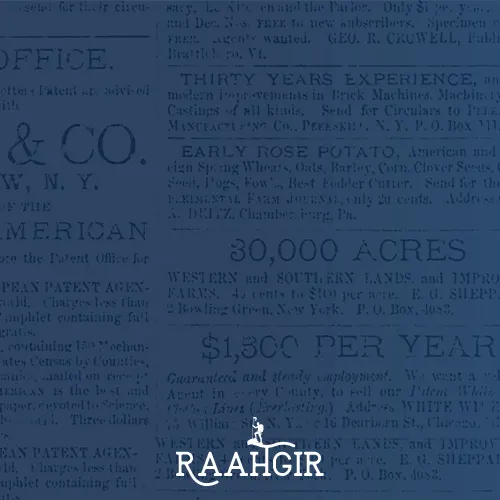
Newsletter
Sign up now!
Be the first one to know all about the Exciting Offers, Travel Updates and more.

B-42, 2nd Floor, Tower- B, The Corenthum, Block A, Sector 62, Noida, Uttar Pradesh 201301
© 2015-2025 JustWravel Pvt. Ltd.
Starts From
₹ 19,000

